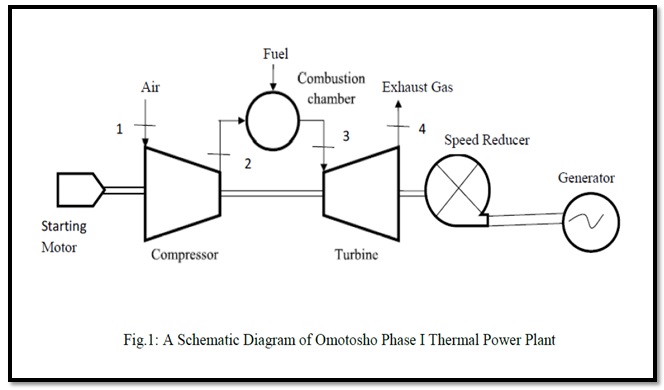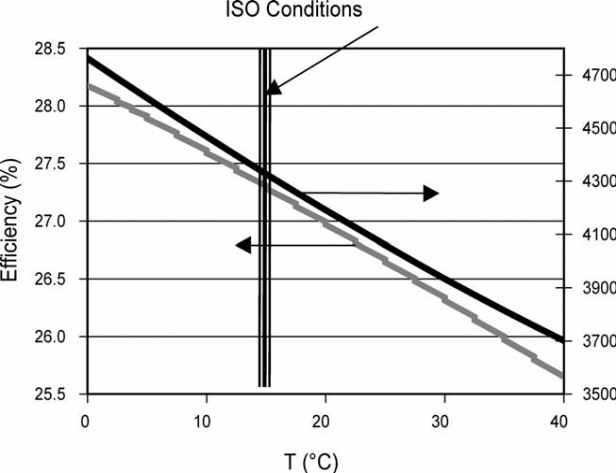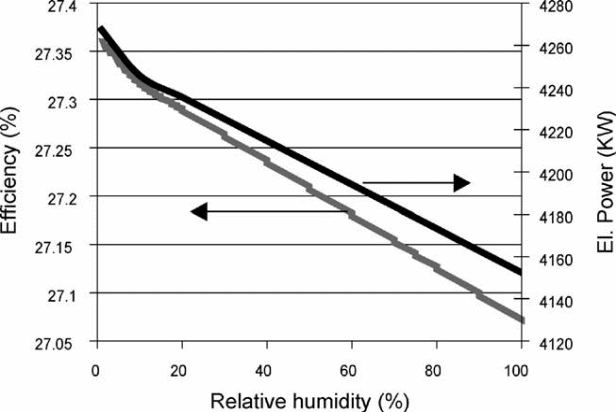Introduction
Gas turbines have simple ways of operating them with regard to starting and stopping. These qualities make gas turbines useful during peak periods in energy demand. In Saudi Arabia, gas turbines have become the primary means of generating electricity because of the presence and low prices of natural gas relative to distillate fuels (Egware and Obanor 206). As a result, gas turbines are utilized based on load units. It is imperative to conduct energy analysis in order to determine sources of energy loss during conversion stages in the plant, as well as evaluate factors that affect the plant performance for efficient usages of gas turbines for power generation.
Traditionally, energy analysis involves evaluating the energy use in operations that entail chemical or physical processing of materials and the transfer and or conversion of energy (Egware and Obanor 206). Energy analysis involves conducting energy balances, which rely on the First Law of Thermodynamics (FLT) and assessing efficiency of the energy. The energy balance is necessary for determining waste and in some cases, recovery of heat.
Today, the most common method of determining thermal systems in heat and power cycles is energy analysis. Specifically, it is useful in fuel usage and electrical efficiency. During the 20th century, the use of energy analysis developed, and today, it is the most established method of assessing thermal systems.
The first law of thermodynamics is the principle that guides energy analysis and the continuity equation over the system and its elements make the energy analysis a dominant method (Egware and Obanor 207). The focus of energy analysis is to enhance thermal effectiveness of a system.
The Brayton cycle is the thermodynamic cycle in which all gas turbines run. A gas turbine consists of compressor, combustors, generator, and turbine as the main parts. A number of researchers have conducted this study in Saudi Arabia. However, in these studies, these authors have failed to include the work ratio and impacts of ambient temperatures because they influence power out and effectiveness of the plants in their analyses. It is imperative to recognize that turbine power out and efficiency decline as the compressor inlet temperature escalates. This report focuses on energy analysis in the thermal power plant.
Thermodynamic Functional Standard of the Plant
The plant operates on an open Brayton cycle. Figures 1 and 2 illustrate schematic and temperature and entropy (T – s) respectively. During initial stages of running the plant, an electric motor operates the axial flow compressor until it achieves 60 percent of the turbine shaft speed. The compressor relies on 60 percent of the turbine shaft work in order to operate itself. This implies that the highest thermal efficiency it can achieve is 40 percent.
When the turbine starting system starts to operate, the air intake plenum draws in ambient air. It cleans air at point 1 and compresses the same air at the 17-stage axial-flow compressor. The 11th stage extraction valve opens and the changeable inlet guide vanes assume a closed position for pulsation protection when the system starts. When the system operates at 95 percent speed, the extraction bleed valves close automatically without any interventions. During this process, the compressed air from the compressor moves to the annular space that surrounds ten combustion sections at point 2 where it flows into the combustion liners. Air enters the combustion compartment via metering holes in every combustion liner for effective fuel burning.
All the ten equal flow lines supply fuel through the end of the fuel nozzle. The nozzle supplies fuel to the combustion area at a steady rate that meets the speed and load requirements of the gas turbine. Once the fuel is in the combustion chamber, it mixes with compressed air and the spark plugs ignite it. This action results in the propagation of the flame by cross-connecting fire tubes to reach all other sections of the combustion. The combustion compressor affects the spark plugs by making them retract when the turbine rotor blade estimates the operating speed. This results in the removal of electrodes from the hot flame area. The system has a design that enhances effective dilution and cooling.
The hot gas that originates from the combustion section increases to ten different transition pieces, which are at the end of the chamber liners. It then flows to the 3-stage turbine of the system at the point 3. In every nozzle of the turbine, there is an increment of kinetic energy as related pressure decreases in every nozzle because of the row of the buckets in motion. Some of the kinetic energies undergo conversion and become useful in powering the turbine rotor.
Gases move into the exhaust area and diffusers after they pass through the third stage buckets. This area has several rotating vanes, which turn gases from the axial direction to radial direction with low exhaust hood wastage. At the fourth point, gases move into the exhaust plenum and escape into the atmosphere via the exhaust stack.
Some of the energies from the turbine run the compressor while the rest are available for other purposes at the output flange of the gas turbine. The speed reducer reduces the speed to 3000 rpm of the generator. The generator then transforms the mechanical energy into electrical energy.


Introduction to Saudi Arabia
The Kingdom of Saudi Arabia has a desert climate. As a result, the country experiences large differences in both daily and seasonal ambient temperatures. This leads to a considerable rise in the demand for electricity between day and night, and winter and summer. During the middle of the day in summer, there is a high demand for electricity because of cooling loads that need energy for air conditioning (Al-Ibrahim and Varnham 1879). Figure 3 below indicates electricity consumption by the largest facility in Riyadh during summer in a day. Electric power utilization in this facility reaches nearly nine MW during peak times. This is twice as much as the usage during off-peak periods.
In the last decade between 1999 and 2009, Saudi Arabia experienced a rapid growth in industries alongside a significant increment in population. These developments resulted in high demands for electricity in the range of five to seven percent every year. Moreover, low prices of fuel and electricity tariffs also facilitated demands in electric power. On the same note, the number of electricity consumers increased by 64 percent to 5.7 million while electricity sales rose by 70 percent to 193 TWh and the peak demand for electric power increased to 40 GW, which represented 82 percent. In order to cater to electricity demand in the future, the Ministry of Water and Electricity has planned to add 35 GW for the peak demand by the year 2023, which will cost approximately $120 billion.
Apart from escalating demands for electric energy, Saudi Arabia also faces a fast escalating demand for desalinated water. Much of the water comes from the cogeneration plants that transfer surplus energy to the electricity grid. The Saline Water Conversion Company has also planned joint power and water initiatives to meet the rising demand. These projects would cost approximately $50 billion by 2020.
The Kingdom could only solve the rising power and desalinated water demands by making massive investments in new projects and updating the existing facilities. The Electric Utility Company of Saudi Arabia (SEC) generated 178 430 GWh of electricity in 2008. About 79 130 GWh (44.3 percent) came from a simple process of combustion turbines, 8.5 percent (15 131 GWh) came from combined cycle combustion turbines, 45.8 percent, which represented 81 770 GWh was generated from steam turbines and 2399 GWh (1.3%) was produced by diesel engines (Al-Ibrahim and Varnham 1880). The effectiveness of combustion turbines (CT) declines as the inlet air temperature rises. This implies that the rising demand for air-conditioning renders the turbine less effective in meeting the demand. The incident with a simple cycle CT indicated that increased midday ambient temperatures in summer could result in a 24 percent decrease in the capacity of the system as witnessed in the central Qaseem region in Saudi Arabia.

Impact of the ambient temperature difference on the performance of gas turbine plants
Simple cycle gas turbine
A commercial solar gas turbine with a small power output of 4327 kW could demonstrate the impact of ambient air temperature differences on the power output and effectiveness of a gas turbine. The demonstration was conducted at ISO conditions by using the IPSEPRO simulation program (Kakaras, Doukelis and Karellas 2350). The manufacturer provided data related to air mass flow, flue gas exit temperature, and pressure ratio among others. These are data, which are necessary for accurate demonstration of the gas turbine efficiency and power output. IPSEPRO is a software program for analyzing heat balances and stimulating activities. The software has a wide application in the energy supply, equipment modeling, alternative energy sources, wastewater treatment, separation processes, desalination, and refrigeration. The software creates a process model by using user-friendly flow sheet editor. These elements could be from a model library. Further, users can develop new part models or develop a completely new model library by using IPSEPRO’s Model Development Kit (MDK). The most significant factor is the reliability of the software. One could prove this by observing its widespread usage in thermodynamic cycle analyses.
Some authors have classified the IPSEPRO software among the most advanced commercial products in thermodynamic analyses (Kakaras et al 2850). There are also other existing software solutions for thermodynamic calculations, such as Cycle Tempo 4.14, Aspen Plus 10.0, and Gate Cycle 5.22.0.r among others.
Analyses of the efficiency and power output include calculations of different ambient temperatures at a specific relative humidity of 45 percent. Figure 4 shows the outcome of simulation analyses.
From the figure, one can observe that the impact of the temperature difference on both efficiency and power output of the cycle becomes prominent. For instance, the rate of efficiency decline is as high as 1.66 percent at a temperature of 40 vC. At the same time, power output declines by 14.48 percent relative to ISO standard conditions of 15 vC. The relative humidity of the ambient temperature is also a factor that affects the performance of a gas turbine. The effect has been controlled at a stable intake-air temperature of 15 vC. The system indicated that the compressor’s output increased as air humidity increased, whereas the turbine’s performance somewhat declined. This resulted in a net decline in the power output. At the same time, these changes also affect the efficiency of the gas turbine. Figure 5 shows the outcome of simulation with a decline rate of 0.28 percent in the effectiveness and a decline of 2.7 percent in the electrical power output with an absolute increment of 100 percent from zero percent humidity i.e., from dry to saturated air.


Methodology
Air coolers
- Spray cooler
- Control spray fogging cooler
Both glasses of water spraying cooler and control fogging cooler are developed as an adiabatic saturator that supplies air to the compressor with a completely saturated air of 100 percent relative humidity (Alhazmy and Najjar 415). The temperature of the air becomes the same as the temperature of the wet-bulb because of passing through the water-spraying cooler. Both relative humidity and ambient air temperature affect the exit air temperature.
Works Cited
Alhazmy, M.M. and Y.S.H. Najjar. “Augmentation of gas turbine performance using air coolers.” Applied Thermal Engineering 24 (2004): 415–429. Print.
Al-Ibrahim, Abdulrahman and Abdulhadi Varnham. “A review of inlet air-cooling technologies for enhancing the performance of combustion turbines in Saudi Arabia.” Applied Thermal Engineering 30 (2010): 1879-1888. Print.
Egware, Henry and A.I. Obanor. “Energy Analysis of Omotosho Phase 1 Gas Thermal Power Plant.” International Journal of Engineering & Technology Sciences (IJETS) 1.4 (2013): 206-217. Print.
Kakaras, E., A. Doukelis, and S. Karellas. “Compressor intake-air cooling in gas turbine plants.” Energy 29 (2004): 2347–2358.